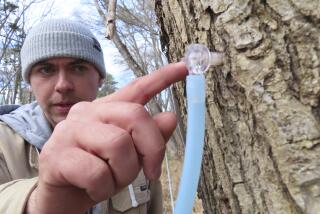Sales Keep Getting Better : Distillery Makes Its Mark With Dad’s Bourbon Recipe
- Share via
LORETTO, Ky. — T. William Samuels Jr. drove for a little more than an hour, through the lush rolling bluegrass country of Central Kentucky, to this small Marion County hamlet--time enough to relate many of the highlights of the 200-year history of bourbon.
Kentucky, birthplace of the whiskey in the 1780s, produces 87% of the world’s bourbon. Even Frankfort, the state capital, has bourbon distilleries--Old Granddad, Ancient Age and Old Crow. At peak season this year, said Frank Dailey, 72, president of the Kentucky Distillers Assn., 6,980 Kentuckians were employed by the bourbon industry. The distilleries had a total payroll of $85.6 million last year.
Samuels, 47, widely known as the historian and archivist of the bourbon industry, is a 7th-generation whiskey distiller and president of Maker’s Mark, smallest of Kentucky’s 14 bourbon distilleries.
While bourbon sales have been declining for the past 20 years, the situation at Maker’s Mark in Loretto, population 1,000, has been just the opposite. Since Maker’s Mark brand of 90-proof Kentucky straight old-style sour mash whiskey went on the market 28 years ago, sales have averaged an annual 8% growth. In 1986, Maker’s Mark had $10.7 million in gross sales. This year’s sales are expected to be $11.5 million.
In 1967, bourbon’s peak production year, Kentucky’s distilleries, then numbering 24, produced 105 million gallons for aging in charred oak casks. In 1986, 49.8 million gallons were produced, down 5% from the previous year, Dailey said.
Arthur Gootee, 64, one of the 50 employees of Maker’s Mark and a distiller for 42 years said, “Here it’s quality more so than quantity.”
Maker’s Mark produced only 143,000 cases of bourbon last year, while Jim Beam, the industry’s largest distillery, produced 4 million cases. Maker’s Mark has a 1,000-gallon daily production capacity. Jim Beam’s typical day is 40,000 gallons.
“We keep an eye on the whiskey all the time,” Gootee said, “from the minute the ingredients go into the huge 9,000-gallon, 19th-Century cypress vats for fermenting, as we distill the mash twice in a copper still and all through the aging process in the rack houses where barrels are routinely turned, tapped and sampled to maintain quality control.”
“My dad wanted to produce the best bourbon possible,” said Samuels, explaining the success of Maker’s Mark, a premium bourbon that sells for about $12.50 a fifth. “He experimented and worked for 10 years to come up with a better bourbon. Finally the first bottles of Maker’s Mark went on sale in 1959.”
John Samuels migrated to Pennsylvania from Ireland in 1715 and began making rye whiskey. On his office wall Bill Samuels has the original 1779 tax bill for his great, great, great, great grandfather Taylor William Samuels’ still. The next year the Samuels clan moved to the hills of Kentucky, where they have been making whiskey ever since.
T. William Samuels Sr., 77, third in the long line of Samuels in the distillery business to have the name Taylor William, sold the much larger T. W. Samuels Distillery in the early 1950s and purchased a little country distillery which fit his fancy.
Maker’s Mark distillery is a collection of quaint frame and limestone whiskey-making buildings, many dating back to 1805 when bourbon was first distilled on the site, which has been designated a national landmark. A stream meanders through the property.
Samuels Sr. decided his “perfect” bourbon would be aged longer and made of corn, barley malt, iron-free spring water, yeast and wheat instead of the traditional rye.
When the whiskey makers moved from Pennsylvania to Kentucky they began using corn as a basic ingredient with rye as an added ingredient. At Maker’s Mark the grain in bourbon is 70% corn, 16% wheat, 14% malted barley. Other bourbon distillers use rye instead of wheat. It takes 6 1/2 years for the aging process at Maker’s Mark.
“What wheat has done, replacing rye, is remove the bite without taking out the robust character of bourbon, making a much mellower, smoother drink. To make a superior bourbon, as we do, the distilling and aging process takes much longer. That’s why demand for Maker’s Mark exceeds supply,” said Bill Samuels Jr.
In 1981, Bill Samuels Sr. sold the distillery to Hiram Walker for an undisclosed price. He retired and his son remained as president of Maker’s Mark. A year ago, Allied Lyons Ltd., a British company, bought the distillery from Hiram Walker with Bill Samuels Jr. again staying on as president.
A graduate of Case Institute of Technology, Bill Jr., did graduate work at UC Berkeley in engineering physics and later graduated from Vanderbilt with a law degree. “But I never practiced law. I have bourbon in my blood. With great grandfathers going back to 1715 and probably even before that in the business of making whiskey, it was meant to be that I run a distillery. I love it,” he said.
More to Read
Sign up for The Wild
We’ll help you find the best places to hike, bike and run, as well as the perfect silent spots for meditation and yoga.
You may occasionally receive promotional content from the Los Angeles Times.






